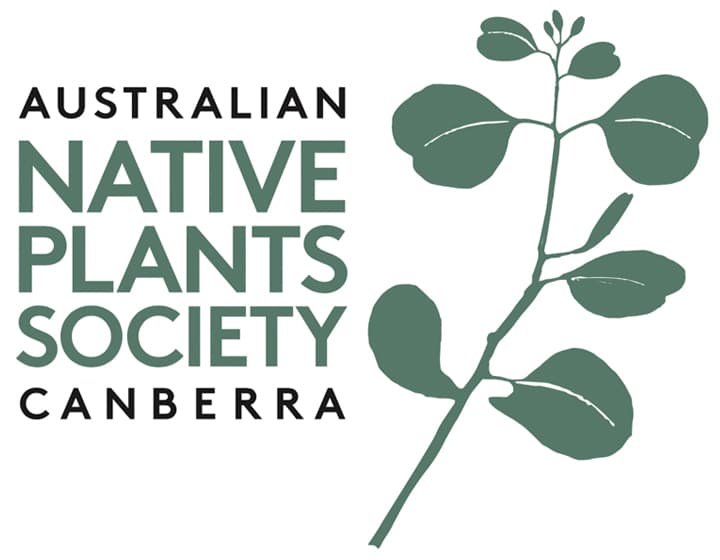Post-fire regeneration of vegetation a ‘remarkable’ phenomenon or a natural occurrence
By Roger Farrow
June 2021
The impact of the recent bushfires on the vegetation has been invariably described in the media in terms of superlatives. First, the ‘destruction’ of the plant landscapes by the fires and later by their ‘remarkable’ recovery. The severity of these fires has also been seized upon as a consequence of global warming.

These statements need to be put into context.
First: Australia’s flora is dominated by fire-dependant, flammable sclerophyllous trees and shrubs, notably eucalypts. Flammable biomes (distinct biological communities) go back to the start of the Paleogene 50 million years ago era when the climate became markedly drier (Crisp et al 2011) so the plants have become well adapted to recover from fire, however severe. Eucalypts and other Myrtaceae regenerate foliage destroyed by fire by the activation of epicormic buds buried deep under the bark and by regrowth from underground lignotubers.
Second: our current climate fluctuates between wet and dry periods that are now known to be driven by changes in ocean temperature in both the Indian (the Indian Dipole) and Pacific Oceans (the El Nino-Southern Oscillation) as well as by the position of the southern ocean westerlies (Southern Ocean Annular Mode). When these changes coincide in a positive phase, they produce warmer surrounding ocean temperatures that feed moisture into eastern and northern Australia leading to an increase in precipitation, as witnessed in 2020-2021. The opposite happens when ocean temperatures are lower and dry conditions ensue, although it should be noted that drought-impacted areas rarely extend over the whole continent. It is not known how long plants have adapted to this changing environment but it could also be for an extended period, long before human occupation of this continent.
Third: post-industrial warming amounts to about 1.7ºC and, in my opinion, has only played a minor role in these recent events, namely by increasing the moisture carrying capacity of the atmosphere in a wet period and marginally impacting on the desiccation phase during the preceding dry period. The severity and extent of the recent fires appear no worse that the great conflagration of 1939-1940, although more of Victoria was burnt on that occasion. It is certain that such fires occurred well into the past as charcoal layers in soil cores testify.
Fourth: The intensity of the recent fires was in my opinion, primarily due to the dryness of the vegetation. By December 2019, understory shrubs across large areas of forest, woodland, and heathland of southeastern Australia were observed to be completely desiccated or dead. Eucalypt foliage was similarly affected, especially in local Southern Tablelands Dry Sclerophyll Forest. Lightning strikes during December 2019 initiated the fires in remote and inaccessible areas at several locations and these spread rapidly through forests and heathlands before effectively running out of fuel by the end of January. No amount of controlled burns could have reduced this rapidly accumulating dry fuel load. Substantial rains fell in late February and continued for the next year as a La Nina climate phase became dominant.
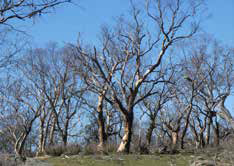
at Smith’s Nature Reserve, Mulloon. May 2020
Observations
I have been following the unfolding situation in fire-affected areas of Moreton and Tallaganda National Parks and in fire free areas of Bango, McClouds Creek and Scott’s Nature Reserves, further west. Five sites were selected along the Nerriga Road in Moreton National Park, namely, Bulee Pass, Touga Road, Pylons, Nissan and Kris’s Knoll.
February 2020
Our first survey in Morton National Park from the Nerriga Road was about a month after the end of the Currawan fire. It was an eerie scene of leafless blackened trees and largely bare, ashcovered ground, with a total absence of any shrub remnants. This certainly gave the impression of a dead landscape but life stirred. A close examination of the trunks of the Silver Top Ash, Eucalyptus sieberi (a stringy bark), at Bulee Pass showed that some trees already had epicormic shoots appearing as well as basal sprouts from the lignotubers. A range of other species were also regenerating from basal shoots, including Banksia spinulosa and Leptospermum obovatum, among others. An association of shrubs, forbs, sedges, lichens and mosses normally grow on the peat layer covering the rock shelves.
Although the shrubs had totally disappeared apart from a few remnant burnt sticks, the mosses (amazingly) were starting to recover and there was a carpet of cotyledons from germinating seedlings of many yet to be identified species but included acacias, eucalypts and hakeas, among others. Farther on, we checked out the Touga Rd site. Again a bleak view, but signs of life from numerous germinating seedlings. The next site examined along the Nerriga road was Nissan that had a well-developed short green sward of emerging leaves of sedges and matt-rushes. This was formerly a dense and impenetrable heathland of low shrubs.

(mud) in foreground, washed downslope.
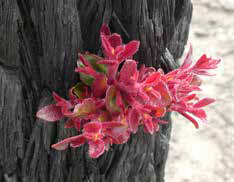
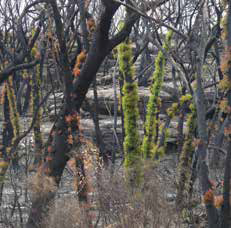
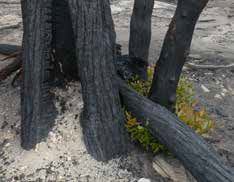
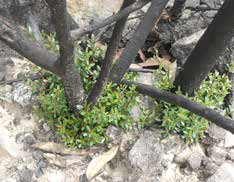
Bulee pass







basal meristem

haemastoma
About meristem
The meristem (the growing
point) of monocotyledons
(grasses, rushes, lilies, grass
trees, etc.), is basal whereas
that of dicotyledons is typically
apical. The leaves of the former
can quickly respond to damage
by fire whereas the shoots of
the dicots must regrow from
basal or epicormic buds.
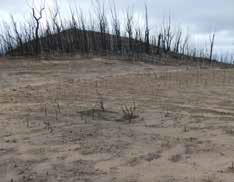
epicormic shoots after fire but instead
rely on seed to regenerate.
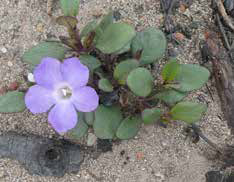
Probably a fire-dependant flowerer.
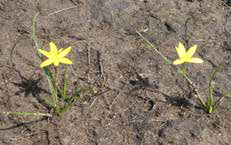
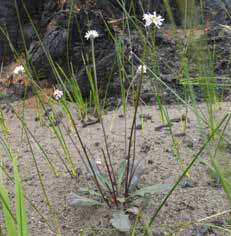
This area was dominated by the gum-barked scribbly gum, Eucalyptus haemastoma. Our final stop beyond Sassafras was at Kris’ Knoll, an area of rock shelf surrounding a casuarina-dominated knoll. Flowers had already appeared on several herbaceous species in this area and were characteristic of species with taproots or corms/bulbs. Germination from seed had also commenced here with seedlings of Acacia appearing, among others but also an unidentified species shown below. At all sites, the conspicuous open capsules of the burnt banksias, callistemons, eucalypts, hakeas, melaleucas and leptospermums, among others, indicated that there had been an abundant seed shed over the landscape.
March-April observations
I made several visits in March and April with colleagues to the four areas visited in February and added a fifth one, namely, the rock shelves known as the Pylons. All five areas are known for their populations of midge orchids, Corunastylis spp. During this month, there was a mass emergence of these orchids, comprising six species, some of which had not been recorded before, presumably because they were concealed among the shrubs. Germination of other plants species also continued apace. Acacias, eucalypts, grevilleas, and many others were readily identifiable at this stage of development, at least to genus, although others were not.
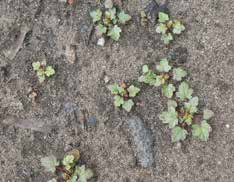
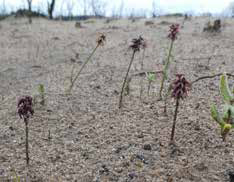
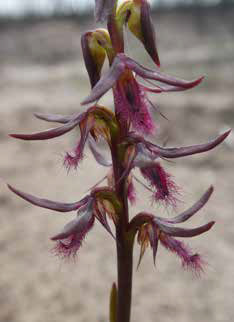
September 2020
The first mass flowering event occurred at Kris’s Knoll where the unidentified seedling shown above was quickly identified from its flower as Commersonia (Rulingia) hermannifolia. It has never been seen here before and is thought to be a fire dependent ephemeral, disappearing between fire events when its seeds remain dormant on the ground. More spring flowering orchids appeared in great abundance, some of them, such as Paraprasophyllum australe, P. brevilabre and P. odoratum, have not seen by us in this area before.

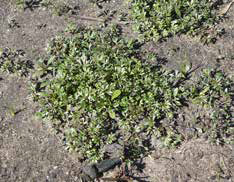
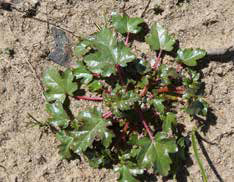



January 2021
Flowering among a range of herbaceous plants continued throughout spring and into summer. In January, a mass flowering of one of the unidentified plants occurred over large areas of sandstone country in Moreton National Park. Coincidentally this mass flowering was also reported in the Blue Mountains where it had not been seen for decades. The plant was the Pink Flannel flower, Actinotus forsythii, discussed in Plant of the Season. This species has never been seen in the two decades we have been visiting this region. It appears to be another fire dependant ephemeral surviving in the seed bank and relaying on the occasional catastrophic fire to resume its life cycle. Many hundreds of plant species are recovering from the fires by a variety of mechanisms. As they grow and are progressively identified it is becoming clear that all the species that were previously there are likely to regenerate. Their relative abundance is changing as herbaceous species will be suppressed but not eliminated by the slower growing woody shrubs. This follows the well-known path of ecological succession. Concerns about the loss of plant species due to high intensity fire is, probably unfounded. Undoubtedly, the abundant rainfall received during 2020 aided the plant recovery.

The Pylons



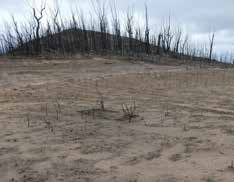
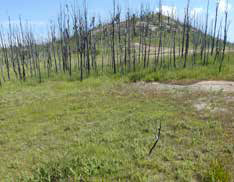
Back to Articles List
